Attached files
| file | filename |
|---|---|
| EX-99.2 - EXHIBIT 99.2 - Booz Allen Hamilton Holding Corp | bahearningsslides123119.htm |
| 8-K - 8-K - Booz Allen Hamilton Holding Corp | fy2020q38kearningsrele.htm |
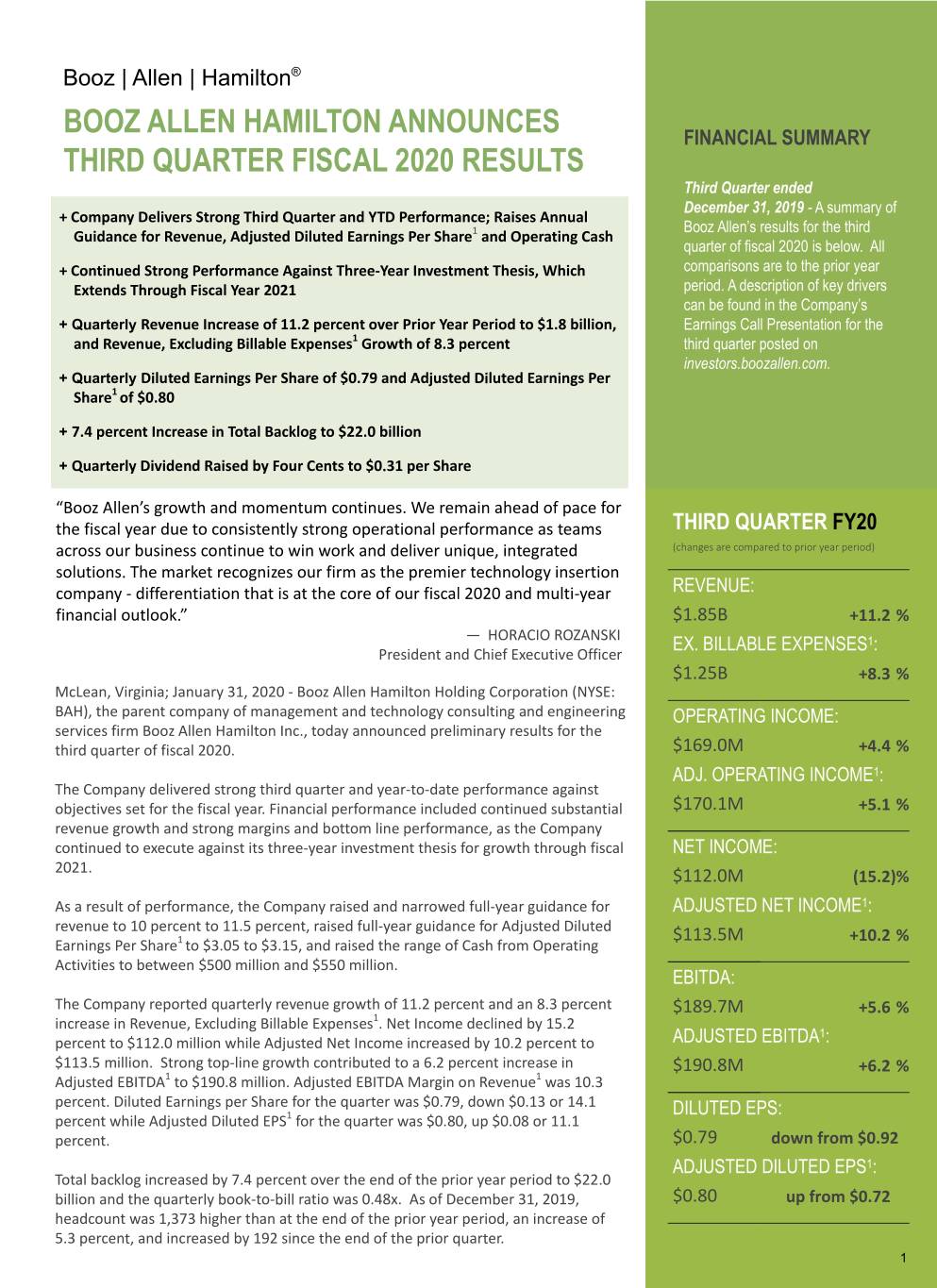
Booz | Allen | Hamilton® BOOZ ALLEN HAMILTON ANNOUNCES FINANCIAL SUMMARY THIRD QUARTER FISCAL 2020 RESULTS Third Quarter ended December 31, 2019 - A summary of + Company Delivers Strong Third Quarter and YTD Performance; Raises Annual Booz Allen’s results for the third Guidance for Revenue, Adjusted Diluted Earnings Per Share1 and Operating Cash quarter of fiscal 2020 is below. All + Continued Strong Performance Against Three-Year Investment Thesis, Which comparisons are to the prior year Extends Through Fiscal Year 2021 period. A description of key drivers can be found in the Company’s + Quarterly Revenue Increase of 11.2 percent over Prior Year Period to $1.8 billion, Earnings Call Presentation for the and Revenue, Excluding Billable Expenses1 Growth of 8.3 percent third quarter posted on investors.boozallen.com. + Quarterly Diluted Earnings Per Share of $0.79 and Adjusted Diluted Earnings Per Share1 of $0.80 + 7.4 percent Increase in Total Backlog to $22.0 billion + Quarterly Dividend Raised by Four Cents to $0.31 per Share “Booz Allen’s growth and momentum continues. We remain ahead of pace for the fiscal year due to consistently strong operational performance as teams THIRD QUARTER FY20 across our business continue to win work and deliver unique, integrated (changes are compared to prior year period) solutions. The market recognizes our firm as the premier technology insertion company - differentiation that is at the core of our fiscal 2020 and multi-year REVENUE: financial outlook.” $1.85B +11.2 % — HORACIO ROZANSKI EX. BILLABLE EXPENSES1: President and Chief Executive Officer $1.25B +8.3 % McLean, Virginia; January 31, 2020 - Booz Allen Hamilton Holding Corporation (NYSE: BAH), the parent company of management and technology consulting and engineering OPERATING INCOME: services firm Booz Allen Hamilton Inc., today announced preliminary results for the third quarter of fiscal 2020. $169.0M +4.4 % ADJ. OPERATING INCOME1: The Company delivered strong third quarter and year-to-date performance against objectives set for the fiscal year. Financial performance included continued substantial $170.1M +5.1 % revenue growth and strong margins and bottom line performance, as the Company continued to execute against its three-year investment thesis for growth through fiscal NET INCOME: 2021. $112.0M (15.2)% As a result of performance, the Company raised and narrowed full-year guidance for ADJUSTED NET INCOME1: revenue to 10 percent to 11.5 percent, raised full-year guidance for Adjusted Diluted $113.5M +10.2 % Earnings Per Share1 to $3.05 to $3.15, and raised the range of Cash from Operating Activities to between $500 million and $550 million. EBITDA: The Company reported quarterly revenue growth of 11.2 percent and an 8.3 percent $189.7M +5.6 % increase in Revenue, Excluding Billable Expenses1. Net Income declined by 15.2 1 percent to $112.0 million while Adjusted Net Income increased by 10.2 percent to ADJUSTED EBITDA : $113.5 million. Strong top-line growth contributed to a 6.2 percent increase in $190.8M +6.2 % Adjusted EBITDA1 to $190.8 million. Adjusted EBITDA Margin on Revenue1 was 10.3 percent. Diluted Earnings per Share for the quarter was $0.79, down $0.13 or 14.1 DILUTED EPS: percent while Adjusted Diluted EPS1 for the quarter was $0.80, up $0.08 or 11.1 percent. $0.79 down from $0.92 ADJUSTED DILUTED EPS1: Total backlog increased by 7.4 percent over the end of the prior year period to $22.0 billion and the quarterly book-to-bill ratio was 0.48x. As of December 31, 2019, $0.80 up from $0.72 headcount was 1,373 higher than at the end of the prior year period, an increase of 5.3 percent, and increased by 192 since the end of the prior quarter. 1
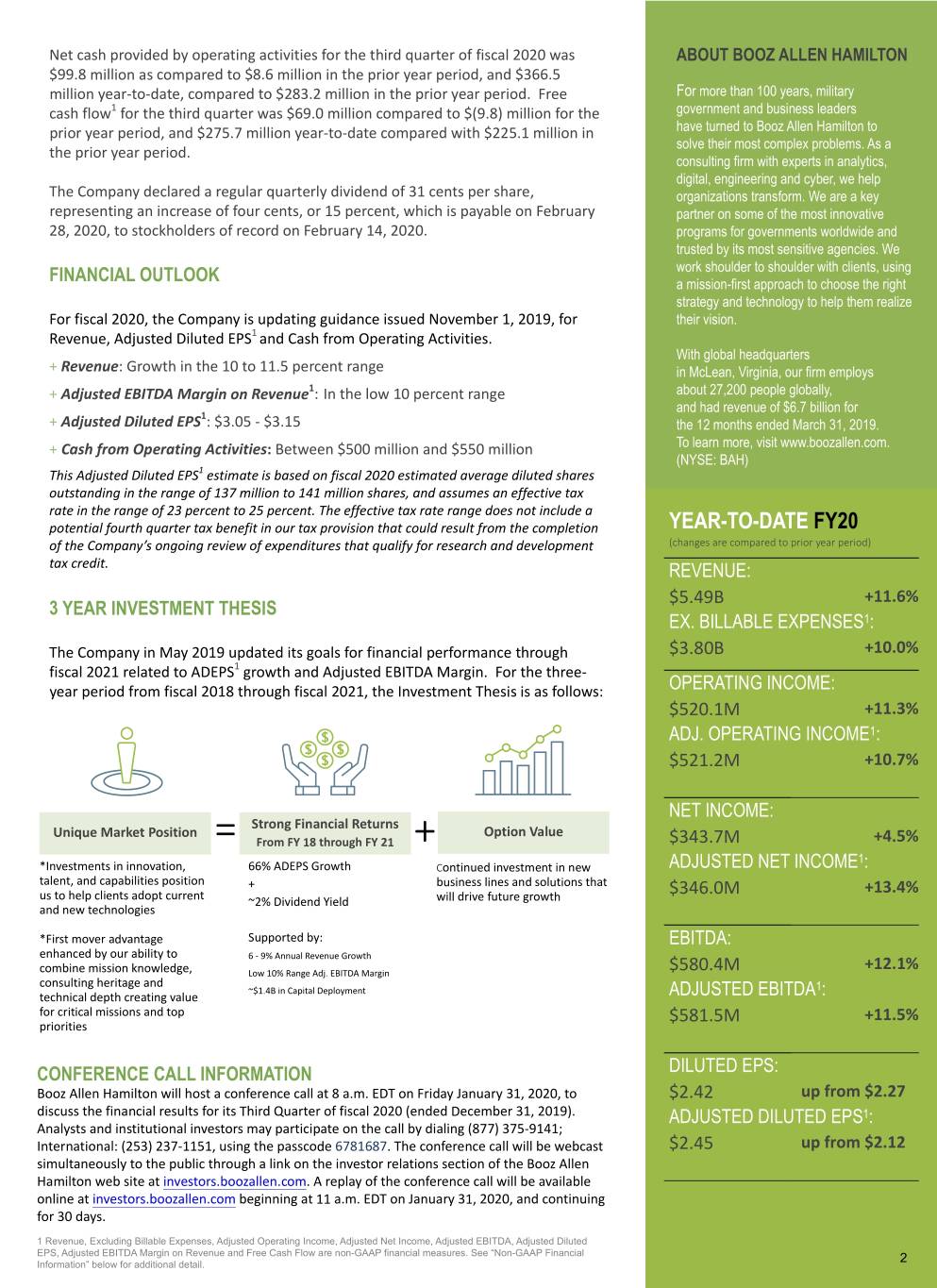
Net cash provided by operating activities for the third quarter of fiscal 2020 was ABOUT BOOZ ALLEN HAMILTON $99.8 million as compared to $8.6 million in the prior year period, and $366.5 million year-to-date, compared to $283.2 million in the prior year period. Free For more than 100 years, military cash flow1 for the third quarter was $69.0 million compared to $(9.8) million for the government and business leaders prior year period, and $275.7 million year-to-date compared with $225.1 million in have turned to Booz Allen Hamilton to solve their most complex problems. As a the prior year period. consulting firm with experts in analytics, digital, engineering and cyber, we help The Company declared a regular quarterly dividend of 31 cents per share, organizations transform. We are a key representing an increase of four cents, or 15 percent, which is payable on February partner on some of the most innovative 28, 2020, to stockholders of record on February 14, 2020. programs for governments worldwide and trusted by its most sensitive agencies. We work shoulder to shoulder with clients, using FINANCIAL OUTLOOK a mission-first approach to choose the right strategy and technology to help them realize For fiscal 2020, the Company is updating guidance issued November 1, 2019, for their vision. Revenue, Adjusted Diluted EPS1 and Cash from Operating Activities. With global headquarters + Revenue: Growth in the 10 to 11.5 percent range in McLean, Virginia, our firm employs + Adjusted EBITDA Margin on Revenue1: In the low 10 percent range about 27,200 people globally, and had revenue of $6.7 billion for 1 + Adjusted Diluted EPS : $3.05 - $3.15 the 12 months ended March 31, 2019. + Cash from Operating Activities: Between $500 million and $550 million To learn more, visit www.boozallen.com. (NYSE: BAH) This Adjusted Diluted EPS1 estimate is based on fiscal 2020 estimated average diluted shares outstanding in the range of 137 million to 141 million shares, and assumes an effective tax rate in the range of 23 percent to 25 percent. The effective tax rate range does not include a potential fourth quarter tax benefit in our tax provision that could result from the completion YEAR-TO-DATE FY20 of the Company’s ongoing review of expenditures that qualify for research and development (changes are compared to prior year period) tax credit. REVENUE: $5.49B +11.6% 3 YEAR INVESTMENT THESIS EX. BILLABLE EXPENSES1: The Company in May 2019 updated its goals for financial performance through $3.80B +10.0% fiscal 2021 related to ADEPS1 growth and Adjusted EBITDA Margin. For the three- year period from fiscal 2018 through fiscal 2021, the Investment Thesis is as follows: OPERATING INCOME: $520.1M +11.3% ADJ. OPERATING INCOME1: $521.2M +10.7% NET INCOME: Strong Financial Returns Unique Market Position Option Value = From FY 18 through FY 21 + $343.7M +4.5% 1 *Investments in innovation, 66% ADEPS Growth Continued investment in new ADJUSTED NET INCOME : talent, and capabilities position + business lines and solutions that $346.0M +13.4% us to help clients adopt current ~2% Dividend Yield will drive future growth and new technologies *First mover advantage Supported by: EBITDA: enhanced by our ability to 6 - 9% Annual Revenue Growth +12.1% combine mission knowledge, Low 10% Range Adj. EBITDA Margin $580.4M consulting heritage and ~$1.4B in Capital Deployment 1 technical depth creating value ADJUSTED EBITDA : for critical missions and top $581.5M +11.5% priorities CONFERENCE CALL INFORMATION DILUTED EPS: Booz Allen Hamilton will host a conference call at 8 a.m. EDT on Friday January 31, 2020, to $2.42 up from $2.27 discuss the financial results for its Third Quarter of fiscal 2020 (ended December 31, 2019). ADJUSTED DILUTED EPS1: Analysts and institutional investors may participate on the call by dialing (877) 375-9141; International: (253) 237-1151, using the passcode 6781687. The conference call will be webcast $2.45 up from $2.12 simultaneously to the public through a link on the investor relations section of the Booz Allen Hamilton web site at investors.boozallen.com. A replay of the conference call will be available online at investors.boozallen.com beginning at 11 a.m. EDT on January 31, 2020, and continuing for 30 days. 1 Revenue, Excluding Billable Expenses, Adjusted Operating Income, Adjusted Net Income, Adjusted EBITDA, Adjusted Diluted EPS, Adjusted EBITDA Margin on Revenue and Free Cash Flow are non-GAAP financial measures. See “Non-GAAP Financial 2 Information” below for additional detail.
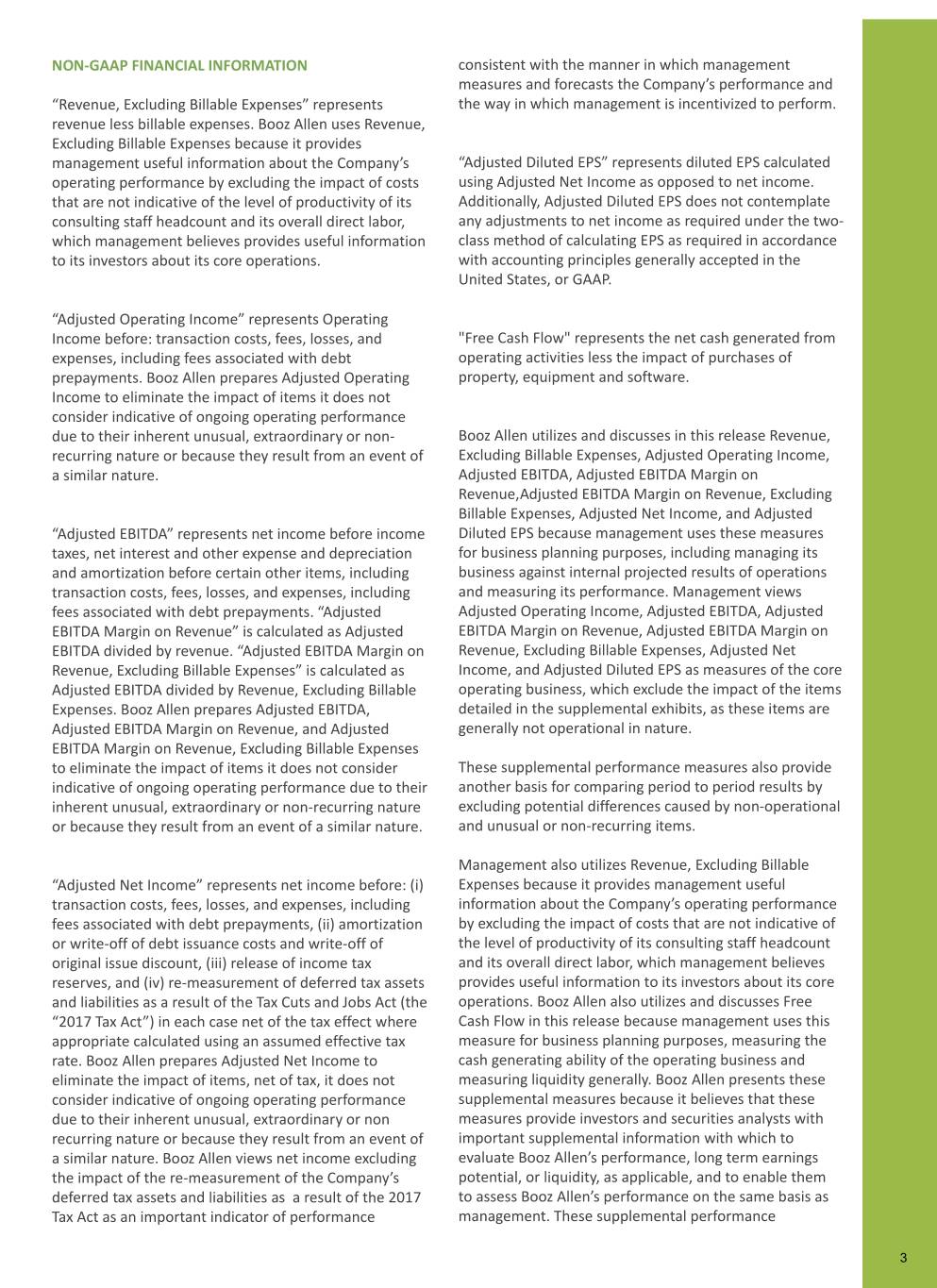
NON-GAAP FINANCIAL INFORMATION consistent with the manner in which management measures and forecasts the Company’s performance and “Revenue, Excluding Billable Expenses” represents the way in which management is incentivized to perform. revenue less billable expenses. Booz Allen uses Revenue, Excluding Billable Expenses because it provides management useful information about the Company’s “Adjusted Diluted EPS” represents diluted EPS calculated operating performance by excluding the impact of costs using Adjusted Net Income as opposed to net income. that are not indicative of the level of productivity of its Additionally, Adjusted Diluted EPS does not contemplate consulting staff headcount and its overall direct labor, any adjustments to net income as required under the two- which management believes provides useful information class method of calculating EPS as required in accordance to its investors about its core operations. with accounting principles generally accepted in the United States, or GAAP. “Adjusted Operating Income” represents Operating Income before: transaction costs, fees, losses, and "Free Cash Flow" represents the net cash generated from expenses, including fees associated with debt operating activities less the impact of purchases of prepayments. Booz Allen prepares Adjusted Operating property, equipment and software. Income to eliminate the impact of items it does not consider indicative of ongoing operating performance due to their inherent unusual, extraordinary or non- Booz Allen utilizes and discusses in this release Revenue, recurring nature or because they result from an event of Excluding Billable Expenses, Adjusted Operating Income, a similar nature. Adjusted EBITDA, Adjusted EBITDA Margin on Revenue,Adjusted EBITDA Margin on Revenue, Excluding Billable Expenses, Adjusted Net Income, and Adjusted “Adjusted EBITDA” represents net income before income Diluted EPS because management uses these measures taxes, net interest and other expense and depreciation for business planning purposes, including managing its and amortization before certain other items, including business against internal projected results of operations transaction costs, fees, losses, and expenses, including and measuring its performance. Management views fees associated with debt prepayments. “Adjusted Adjusted Operating Income, Adjusted EBITDA, Adjusted EBITDA Margin on Revenue” is calculated as Adjusted EBITDA Margin on Revenue, Adjusted EBITDA Margin on EBITDA divided by revenue. “Adjusted EBITDA Margin on Revenue, Excluding Billable Expenses, Adjusted Net Revenue, Excluding Billable Expenses” is calculated as Income, and Adjusted Diluted EPS as measures of the core Adjusted EBITDA divided by Revenue, Excluding Billable operating business, which exclude the impact of the items Expenses. Booz Allen prepares Adjusted EBITDA, detailed in the supplemental exhibits, as these items are Adjusted EBITDA Margin on Revenue, and Adjusted generally not operational in nature. EBITDA Margin on Revenue, Excluding Billable Expenses to eliminate the impact of items it does not consider These supplemental performance measures also provide indicative of ongoing operating performance due to their another basis for comparing period to period results by inherent unusual, extraordinary or non-recurring nature excluding potential differences caused by non-operational or because they result from an event of a similar nature. and unusual or non-recurring items. Management also utilizes Revenue, Excluding Billable “Adjusted Net Income” represents net income before: (i) Expenses because it provides management useful transaction costs, fees, losses, and expenses, including information about the Company’s operating performance fees associated with debt prepayments, (ii) amortization by excluding the impact of costs that are not indicative of or write-off of debt issuance costs and write-off of the level of productivity of its consulting staff headcount original issue discount, (iii) release of income tax and its overall direct labor, which management believes reserves, and (iv) re-measurement of deferred tax assets provides useful information to its investors about its core and liabilities as a result of the Tax Cuts and Jobs Act (the operations. Booz Allen also utilizes and discusses Free “2017 Tax Act”) in each case net of the tax effect where Cash Flow in this release because management uses this appropriate calculated using an assumed effective tax measure for business planning purposes, measuring the rate. Booz Allen prepares Adjusted Net Income to cash generating ability of the operating business and eliminate the impact of items, net of tax, it does not measuring liquidity generally. Booz Allen presents these consider indicative of ongoing operating performance supplemental measures because it believes that these due to their inherent unusual, extraordinary or non measures provide investors and securities analysts with recurring nature or because they result from an event of important supplemental information with which to a similar nature. Booz Allen views net income excluding evaluate Booz Allen’s performance, long term earnings the impact of the re-measurement of the Company’s potential, or liquidity, as applicable, and to enable them deferred tax assets and liabilities as a result of the 2017 to assess Booz Allen’s performance on the same basis as Tax Act as an important indicator of performance management. These supplemental performance 3
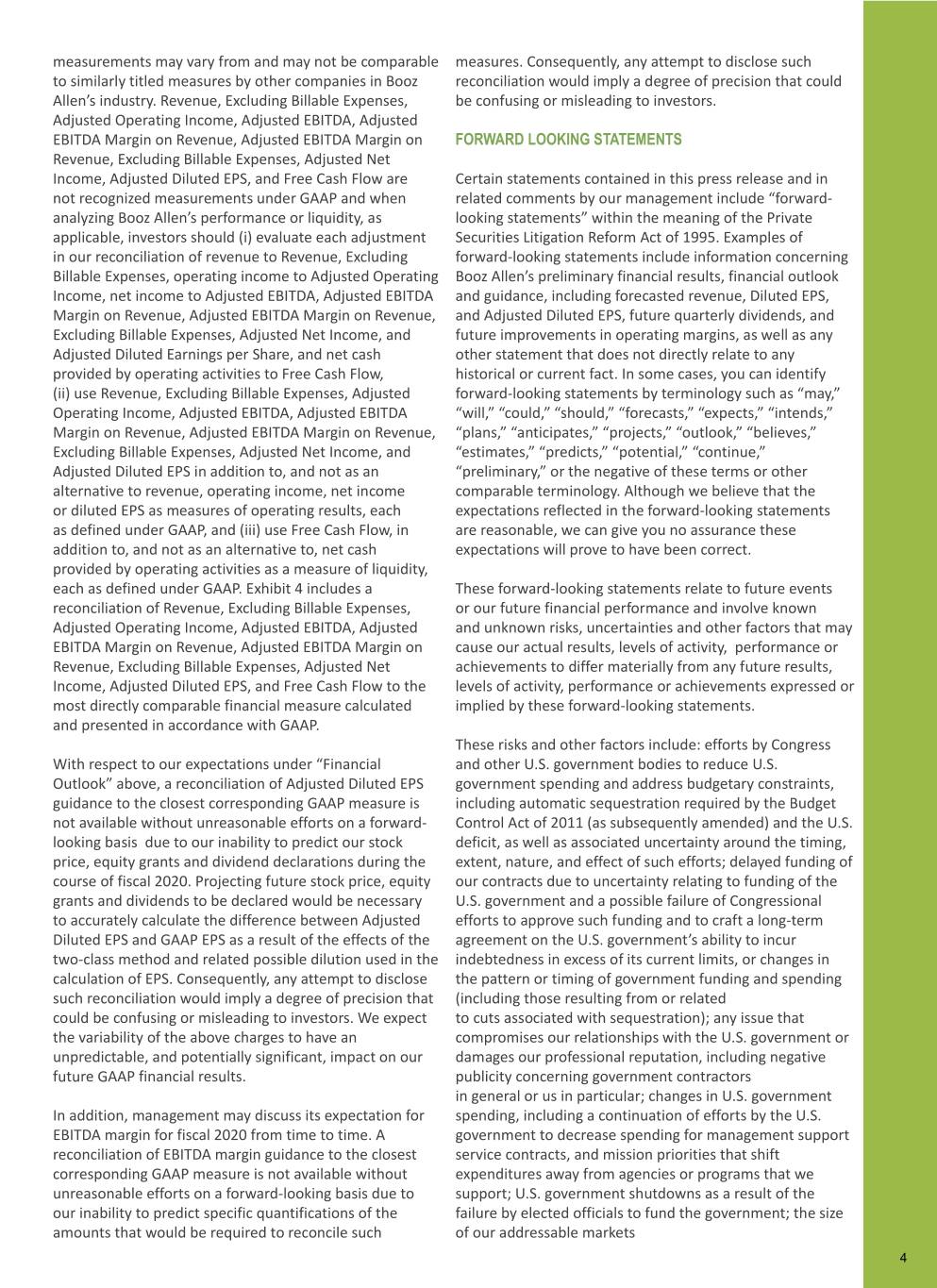
measurements may vary from and may not be comparable measures. Consequently, any attempt to disclose such to similarly titled measures by other companies in Booz reconciliation would imply a degree of precision that could Allen’s industry. Revenue, Excluding Billable Expenses, be confusing or misleading to investors. Adjusted Operating Income, Adjusted EBITDA, Adjusted EBITDA Margin on Revenue, Adjusted EBITDA Margin on FORWARD LOOKING STATEMENTS Revenue, Excluding Billable Expenses, Adjusted Net Income, Adjusted Diluted EPS, and Free Cash Flow are Certain statements contained in this press release and in not recognized measurements under GAAP and when related comments by our management include “forward- analyzing Booz Allen’s performance or liquidity, as looking statements” within the meaning of the Private applicable, investors should (i) evaluate each adjustment Securities Litigation Reform Act of 1995. Examples of in our reconciliation of revenue to Revenue, Excluding forward-looking statements include information concerning Billable Expenses, operating income to Adjusted Operating Booz Allen’s preliminary financial results, financial outlook Income, net income to Adjusted EBITDA, Adjusted EBITDA and guidance, including forecasted revenue, Diluted EPS, Margin on Revenue, Adjusted EBITDA Margin on Revenue, and Adjusted Diluted EPS, future quarterly dividends, and Excluding Billable Expenses, Adjusted Net Income, and future improvements in operating margins, as well as any Adjusted Diluted Earnings per Share, and net cash other statement that does not directly relate to any provided by operating activities to Free Cash Flow, historical or current fact. In some cases, you can identify (ii) use Revenue, Excluding Billable Expenses, Adjusted forward-looking statements by terminology such as “may,” Operating Income, Adjusted EBITDA, Adjusted EBITDA “will,” “could,” “should,” “forecasts,” “expects,” “intends,” Margin on Revenue, Adjusted EBITDA Margin on Revenue, “plans,” “anticipates,” “projects,” “outlook,” “believes,” Excluding Billable Expenses, Adjusted Net Income, and “estimates,” “predicts,” “potential,” “continue,” Adjusted Diluted EPS in addition to, and not as an “preliminary,” or the negative of these terms or other alternative to revenue, operating income, net income comparable terminology. Although we believe that the or diluted EPS as measures of operating results, each expectations reflected in the forward-looking statements as defined under GAAP, and (iii) use Free Cash Flow, in are reasonable, we can give you no assurance these addition to, and not as an alternative to, net cash expectations will prove to have been correct. provided by operating activities as a measure of liquidity, each as defined under GAAP. Exhibit 4 includes a These forward-looking statements relate to future events reconciliation of Revenue, Excluding Billable Expenses, or our future financial performance and involve known Adjusted Operating Income, Adjusted EBITDA, Adjusted and unknown risks, uncertainties and other factors that may EBITDA Margin on Revenue, Adjusted EBITDA Margin on cause our actual results, levels of activity, performance or Revenue, Excluding Billable Expenses, Adjusted Net achievements to differ materially from any future results, Income, Adjusted Diluted EPS, and Free Cash Flow to the levels of activity, performance or achievements expressed or most directly comparable financial measure calculated implied by these forward-looking statements. and presented in accordance with GAAP. These risks and other factors include: efforts by Congress With respect to our expectations under “Financial and other U.S. government bodies to reduce U.S. Outlook” above, a reconciliation of Adjusted Diluted EPS government spending and address budgetary constraints, guidance to the closest corresponding GAAP measure is including automatic sequestration required by the Budget not available without unreasonable efforts on a forward- Control Act of 2011 (as subsequently amended) and the U.S. looking basis due to our inability to predict our stock deficit, as well as associated uncertainty around the timing, price, equity grants and dividend declarations during the extent, nature, and effect of such efforts; delayed funding of course of fiscal 2020. Projecting future stock price, equity our contracts due to uncertainty relating to funding of the grants and dividends to be declared would be necessary U.S. government and a possible failure of Congressional to accurately calculate the difference between Adjusted efforts to approve such funding and to craft a long-term Diluted EPS and GAAP EPS as a result of the effects of the agreement on the U.S. government’s ability to incur two-class method and related possible dilution used in the indebtedness in excess of its current limits, or changes in calculation of EPS. Consequently, any attempt to disclose the pattern or timing of government funding and spending such reconciliation would imply a degree of precision that (including those resulting from or related could be confusing or misleading to investors. We expect to cuts associated with sequestration); any issue that the variability of the above charges to have an compromises our relationships with the U.S. government or unpredictable, and potentially significant, impact on our damages our professional reputation, including negative future GAAP financial results. publicity concerning government contractors in general or us in particular; changes in U.S. government In addition, management may discuss its expectation for spending, including a continuation of efforts by the U.S. EBITDA margin for fiscal 2020 from time to time. A government to decrease spending for management support reconciliation of EBITDA margin guidance to the closest service contracts, and mission priorities that shift corresponding GAAP measure is not available without expenditures away from agencies or programs that we unreasonable efforts on a forward-looking basis due to support; U.S. government shutdowns as a result of the our inability to predict specific quantifications of the failure by elected officials to fund the government; the size amounts that would be required to reconcile such of our addressable markets 4
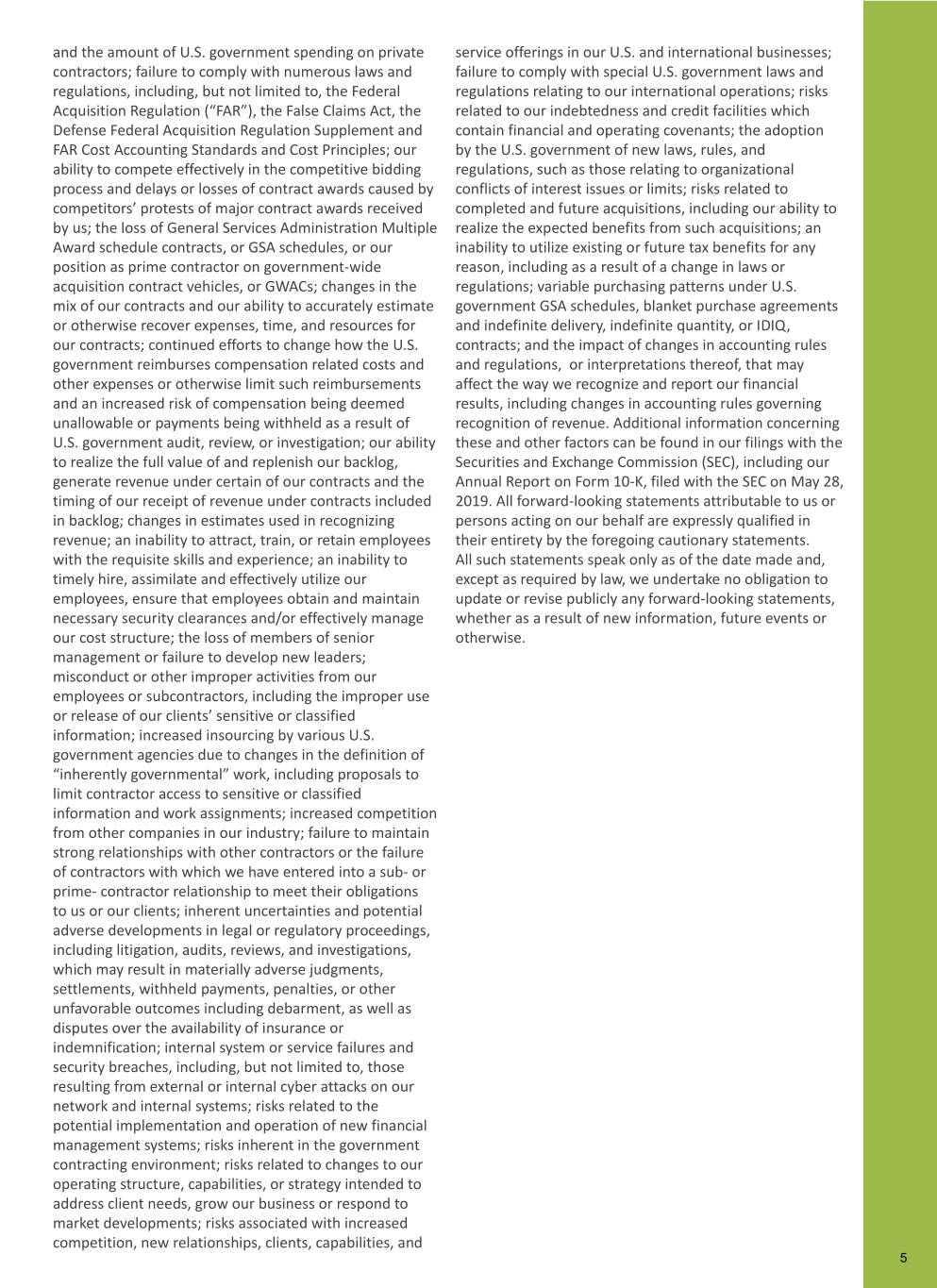
and the amount of U.S. government spending on private service offerings in our U.S. and international businesses; contractors; failure to comply with numerous laws and failure to comply with special U.S. government laws and regulations, including, but not limited to, the Federal regulations relating to our international operations; risks Acquisition Regulation (“FAR”), the False Claims Act, the related to our indebtedness and credit facilities which Defense Federal Acquisition Regulation Supplement and contain financial and operating covenants; the adoption FAR Cost Accounting Standards and Cost Principles; our by the U.S. government of new laws, rules, and ability to compete effectively in the competitive bidding regulations, such as those relating to organizational process and delays or losses of contract awards caused by conflicts of interest issues or limits; risks related to competitors’ protests of major contract awards received completed and future acquisitions, including our ability to by us; the loss of General Services Administration Multiple realize the expected benefits from such acquisitions; an Award schedule contracts, or GSA schedules, or our inability to utilize existing or future tax benefits for any position as prime contractor on government-wide reason, including as a result of a change in laws or acquisition contract vehicles, or GWACs; changes in the regulations; variable purchasing patterns under U.S. mix of our contracts and our ability to accurately estimate government GSA schedules, blanket purchase agreements or otherwise recover expenses, time, and resources for and indefinite delivery, indefinite quantity, or IDIQ, our contracts; continued efforts to change how the U.S. contracts; and the impact of changes in accounting rules government reimburses compensation related costs and and regulations, or interpretations thereof, that may other expenses or otherwise limit such reimbursements affect the way we recognize and report our financial and an increased risk of compensation being deemed results, including changes in accounting rules governing unallowable or payments being withheld as a result of recognition of revenue. Additional information concerning U.S. government audit, review, or investigation; our ability these and other factors can be found in our filings with the to realize the full value of and replenish our backlog, Securities and Exchange Commission (SEC), including our generate revenue under certain of our contracts and the Annual Report on Form 10-K, filed with the SEC on May 28, timing of our receipt of revenue under contracts included 2019. All forward-looking statements attributable to us or in backlog; changes in estimates used in recognizing persons acting on our behalf are expressly qualified in revenue; an inability to attract, train, or retain employees their entirety by the foregoing cautionary statements. with the requisite skills and experience; an inability to All such statements speak only as of the date made and, timely hire, assimilate and effectively utilize our except as required by law, we undertake no obligation to employees, ensure that employees obtain and maintain update or revise publicly any forward-looking statements, necessary security clearances and/or effectively manage whether as a result of new information, future events or our cost structure; the loss of members of senior otherwise. management or failure to develop new leaders; misconduct or other improper activities from our employees or subcontractors, including the improper use or release of our clients’ sensitive or classified information; increased insourcing by various U.S. government agencies due to changes in the definition of “inherently governmental” work, including proposals to limit contractor access to sensitive or classified information and work assignments; increased competition from other companies in our industry; failure to maintain strong relationships with other contractors or the failure of contractors with which we have entered into a sub- or prime- contractor relationship to meet their obligations to us or our clients; inherent uncertainties and potential adverse developments in legal or regulatory proceedings, including litigation, audits, reviews, and investigations, which may result in materially adverse judgments, settlements, withheld payments, penalties, or other unfavorable outcomes including debarment, as well as disputes over the availability of insurance or indemnification; internal system or service failures and security breaches, including, but not limited to, those resulting from external or internal cyber attacks on our network and internal systems; risks related to the potential implementation and operation of new financial management systems; risks inherent in the government contracting environment; risks related to changes to our operating structure, capabilities, or strategy intended to address client needs, grow our business or respond to market developments; risks associated with increased competition, new relationships, clients, capabilities, and 5 5
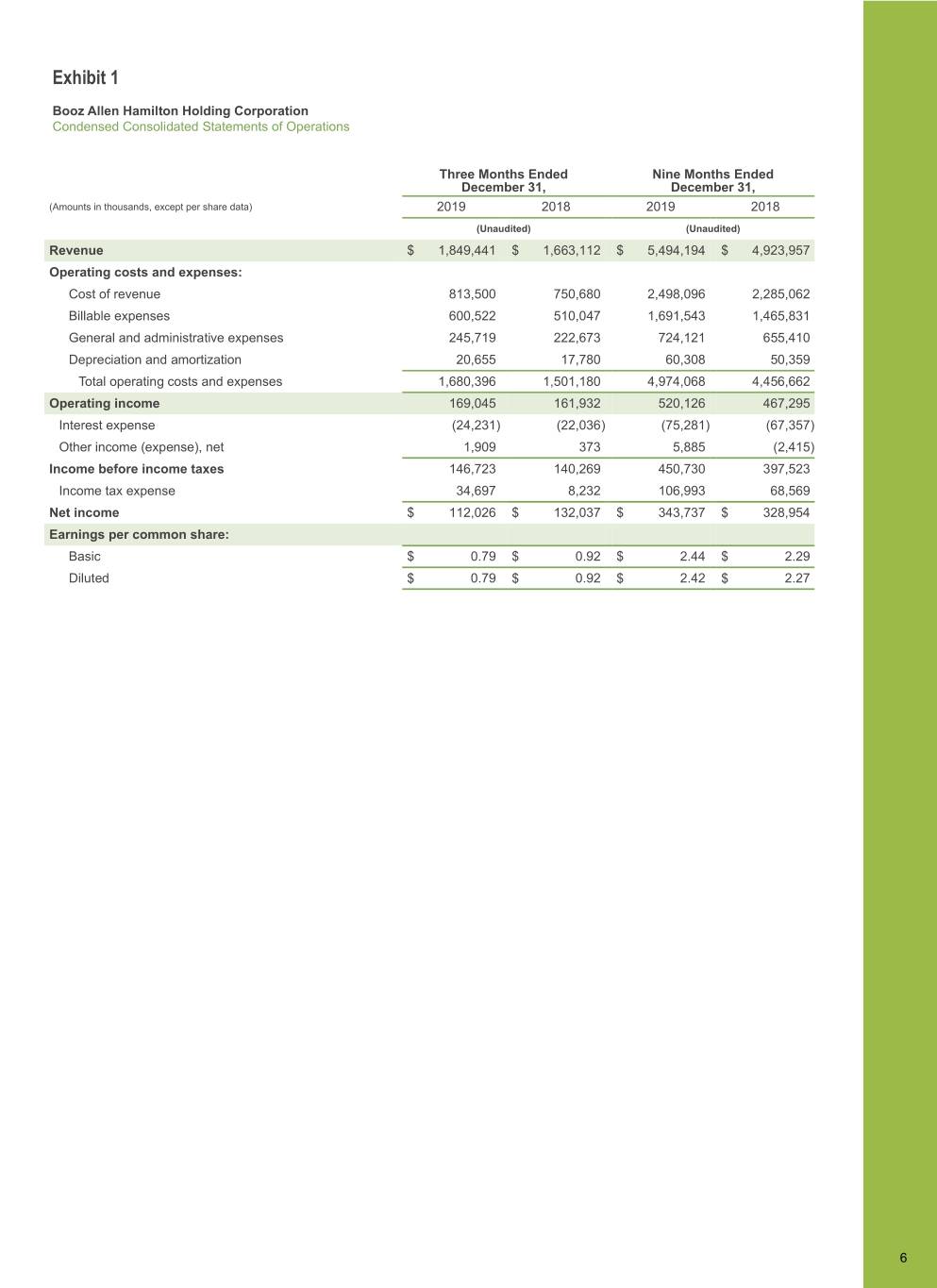
Exhibit 1 Booz Allen Hamilton Holding Corporation Condensed Consolidated Statements of Operations Three Months Ended Nine Months Ended December 31, December 31, (Amounts in thousands, except per share data) 2019 2018 2019 2018 (Unaudited) (Unaudited) Revenue $ 1,849,441 $ 1,663,112 $ 5,494,194 $ 4,923,957 Operating costs and expenses: Cost of revenue 813,500 750,680 2,498,096 2,285,062 Billable expenses 600,522 510,047 1,691,543 1,465,831 General and administrative expenses 245,719 222,673 724,121 655,410 Depreciation and amortization 20,655 17,780 60,308 50,359 Total operating costs and expenses 1,680,396 1,501,180 4,974,068 4,456,662 Operating income 169,045 161,932 520,126 467,295 Interest expense (24,231) (22,036) (75,281) (67,357) Other income (expense), net 1,909 373 5,885 (2,415) Income before income taxes 146,723 140,269 450,730 397,523 Income tax expense 34,697 8,232 106,993 68,569 Net income $ 112,026 $ 132,037 $ 343,737 $ 328,954 Earnings per common share: Basic $ 0.79 $ 0.92 $ 2.44 $ 2.29 Diluted $ 0.79 $ 0.92 $ 2.42 $ 2.27 6 6
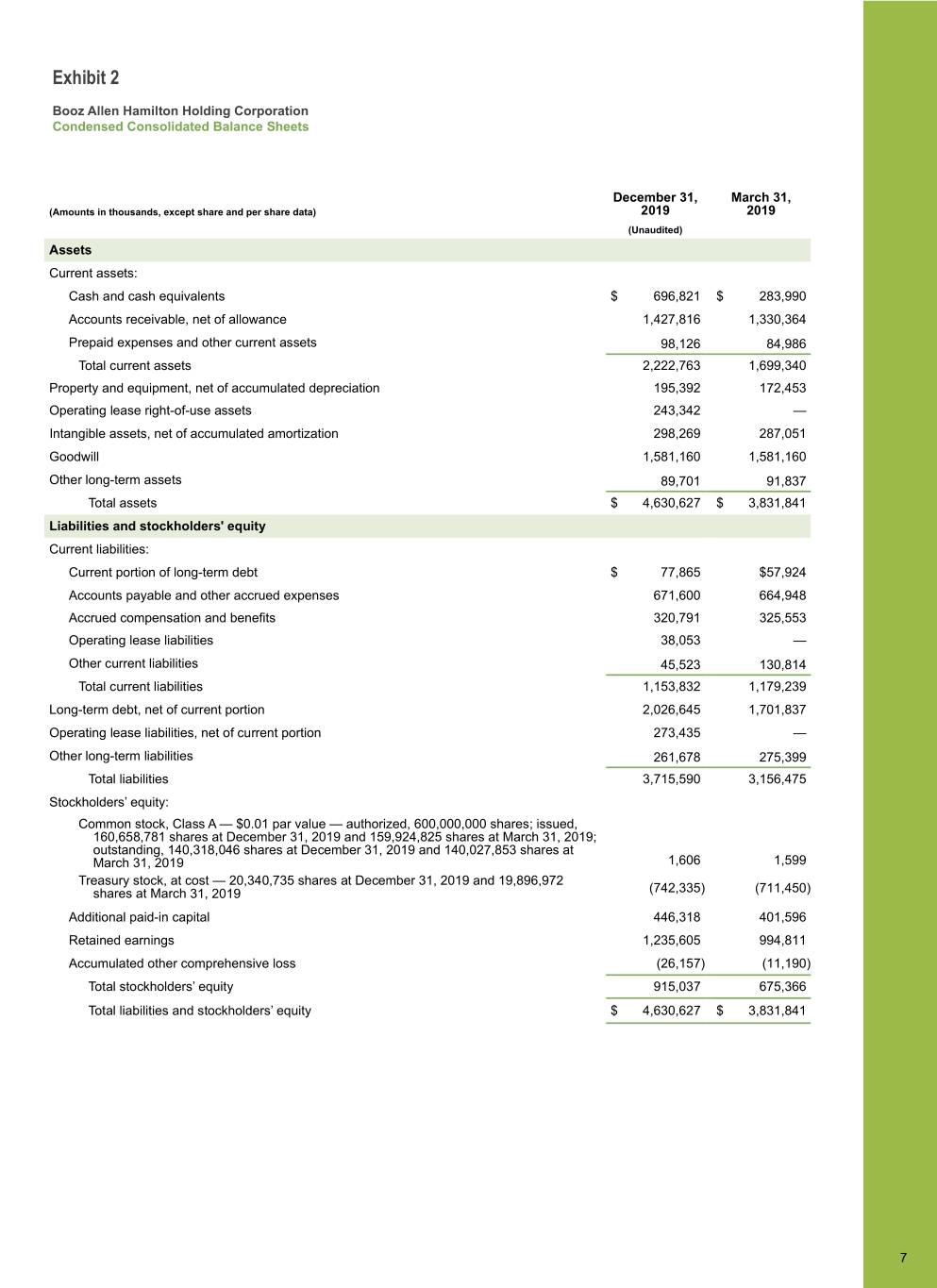
Exhibit 2 Booz Allen Hamilton Holding Corporation Condensed Consolidated Balance Sheets December 31, March 31, (Amounts in thousands, except share and per share data) 2019 2019 (Unaudited) Assets Current assets: Cash and cash equivalents $ 696,821 $ 283,990 Accounts receivable, net of allowance 1,427,816 1,330,364 Prepaid expenses and other current assets 98,126 84,986 Total current assets 2,222,763 1,699,340 Property and equipment, net of accumulated depreciation 195,392 172,453 Operating lease right-of-use assets 243,342 — Intangible assets, net of accumulated amortization 298,269 287,051 Goodwill 1,581,160 1,581,160 Other long-term assets 89,701 91,837 Total assets $ 4,630,627 $ 3,831,841 Liabilities and stockholders' equity Current liabilities: Current portion of long-term debt $ 77,865 $57,924 Accounts payable and other accrued expenses 671,600 664,948 Accrued compensation and benefits 320,791 325,553 Operating lease liabilities 38,053 — Other current liabilities 45,523 130,814 Total current liabilities 1,153,832 1,179,239 Long-term debt, net of current portion 2,026,645 1,701,837 Operating lease liabilities, net of current portion 273,435 — Other long-term liabilities 261,678 275,399 Total liabilities 3,715,590 3,156,475 Stockholders’ equity: Common stock, Class A — $0.01 par value — authorized, 600,000,000 shares; issued, 160,658,781 shares at December 31, 2019 and 159,924,825 shares at March 31, 2019; outstanding, 140,318,046 shares at December 31, 2019 and 140,027,853 shares at March 31, 2019 1,606 1,599 Treasury stock, at cost — 20,340,735 shares at December 31, 2019 and 19,896,972 shares at March 31, 2019 (742,335) (711,450) Additional paid-in capital 446,318 401,596 Retained earnings 1,235,605 994,811 Accumulated other comprehensive loss (26,157) (11,190) Total stockholders’ equity 915,037 675,366 Total liabilities and stockholders’ equity $ 4,630,627 $ 3,831,841 7 7
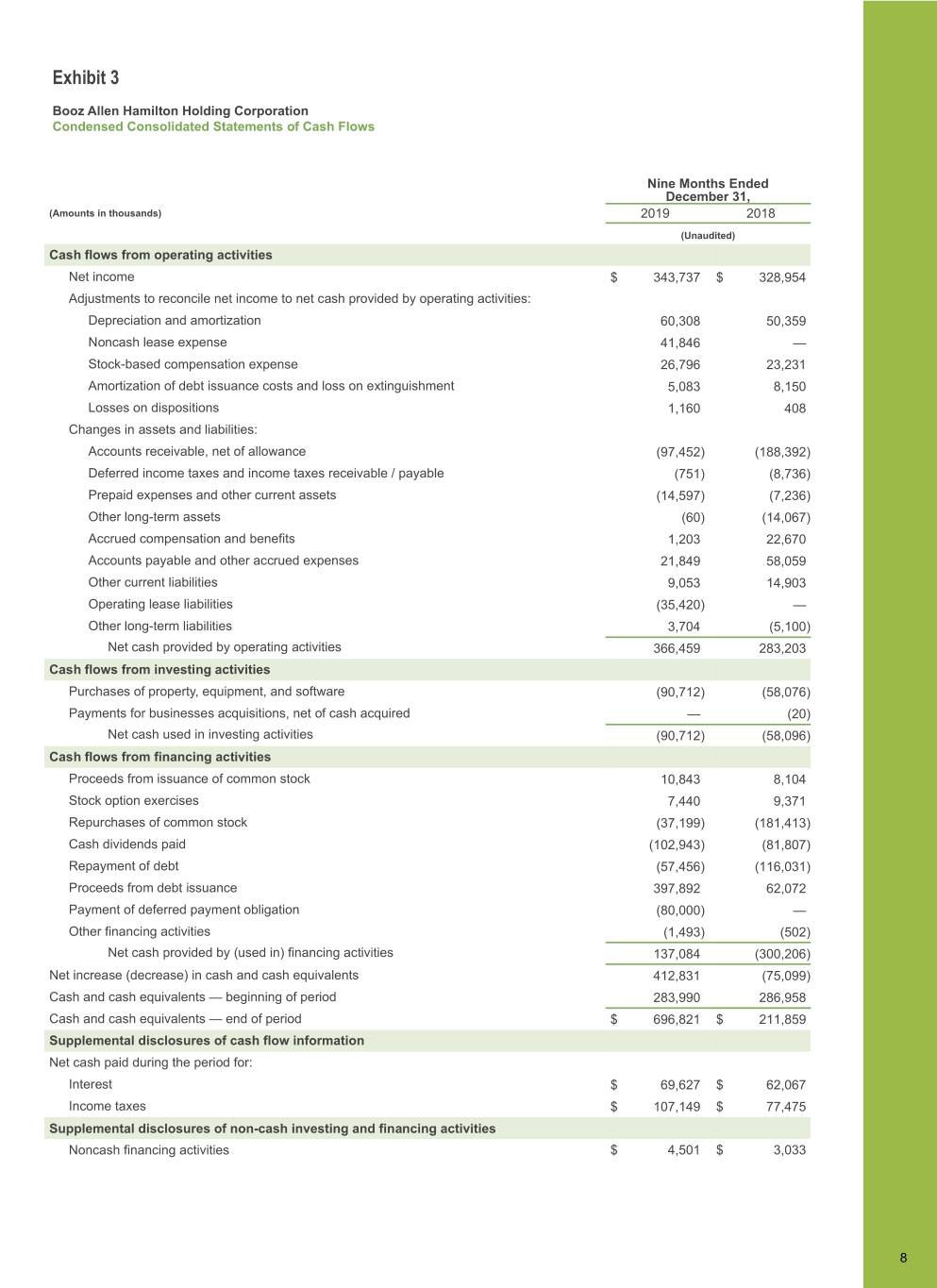
Exhibit 3 Booz Allen Hamilton Holding Corporation Condensed Consolidated Statements of Cash Flows Nine Months Ended December 31, (Amounts in thousands) 2019 2018 (Unaudited) Cash flows from operating activities Net income $ 343,737 $ 328,954 Adjustments to reconcile net income to net cash provided by operating activities: Depreciation and amortization 60,308 50,359 Noncash lease expense 41,846 — Stock-based compensation expense 26,796 23,231 Amortization of debt issuance costs and loss on extinguishment 5,083 8,150 Losses on dispositions 1,160 408 Changes in assets and liabilities: Accounts receivable, net of allowance (97,452) (188,392) Deferred income taxes and income taxes receivable / payable (751) (8,736) Prepaid expenses and other current assets (14,597) (7,236) Other long-term assets (60) (14,067) Accrued compensation and benefits 1,203 22,670 Accounts payable and other accrued expenses 21,849 58,059 Other current liabilities 9,053 14,903 Operating lease liabilities (35,420) — Other long-term liabilities 3,704 (5,100) Net cash provided by operating activities 366,459 283,203 Cash flows from investing activities Purchases of property, equipment, and software (90,712) (58,076) Payments for businesses acquisitions, net of cash acquired — (20) Net cash used in investing activities (90,712) (58,096) Cash flows from financing activities Proceeds from issuance of common stock 10,843 8,104 Stock option exercises 7,440 9,371 Repurchases of common stock (37,199) (181,413) Cash dividends paid (102,943) (81,807) Repayment of debt (57,456) (116,031) Proceeds from debt issuance 397,892 62,072 Payment of deferred payment obligation (80,000) — Other financing activities (1,493) (502) Net cash provided by (used in) financing activities 137,084 (300,206) Net increase (decrease) in cash and cash equivalents 412,831 (75,099) Cash and cash equivalents — beginning of period 283,990 286,958 Cash and cash equivalents — end of period $ 696,821 $ 211,859 Supplemental disclosures of cash flow information Net cash paid during the period for: Interest $ 69,627 $ 62,067 Income taxes $ 107,149 $ 77,475 Supplemental disclosures of non-cash investing and financing activities Noncash financing activities $ 4,501 $ 3,033 8 8
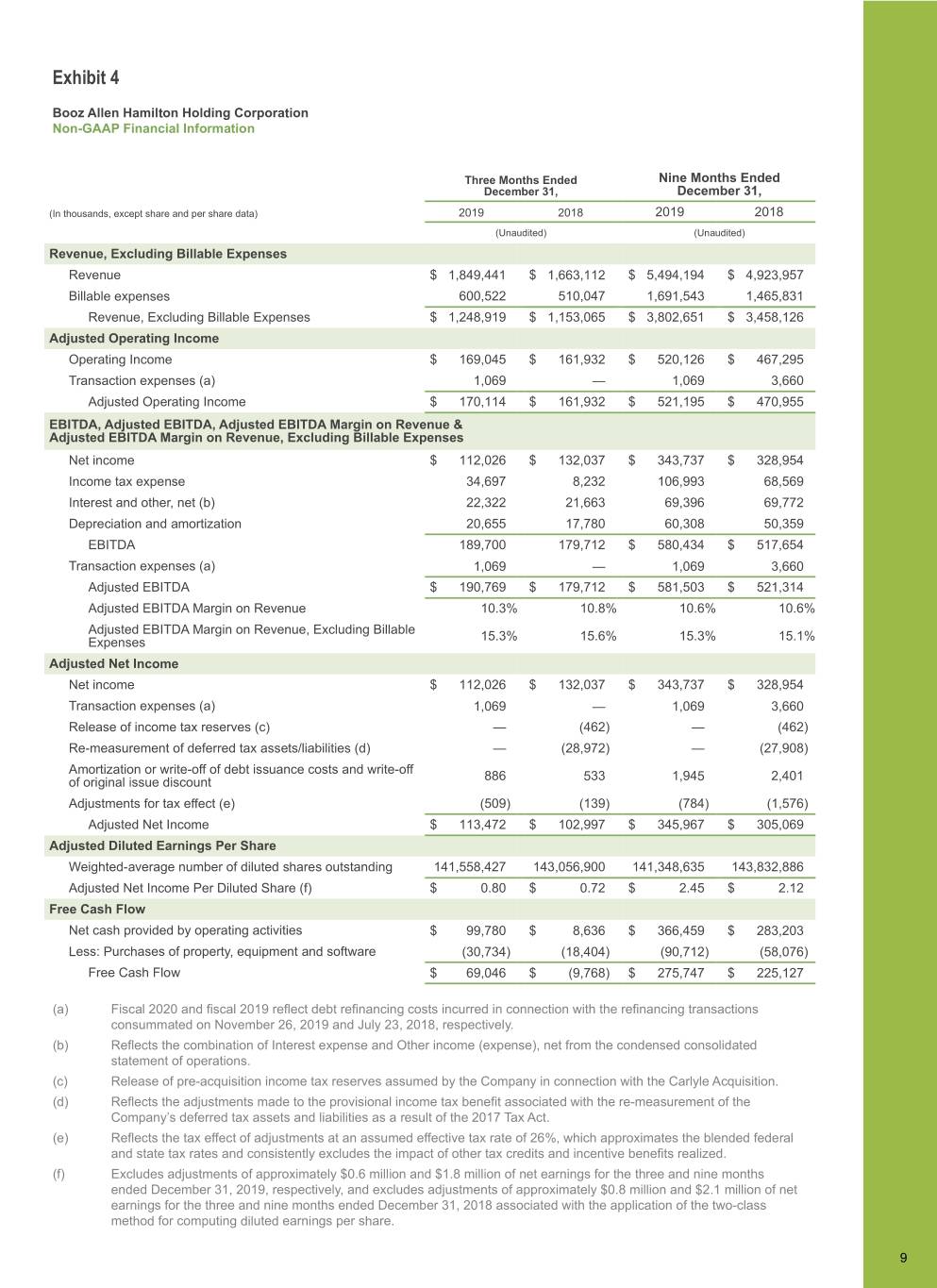
Exhibit 4 Booz Allen Hamilton Holding Corporation Non-GAAP Financial Information Three Months Ended Nine Months Ended December 31, December 31, (In thousands, except share and per share data) 2019 2018 2019 2018 (Unaudited) (Unaudited) Revenue, Excluding Billable Expenses Revenue $ 1,849,441 $ 1,663,112 $ 5,494,194 $ 4,923,957 Billable expenses 600,522 510,047 1,691,543 1,465,831 Revenue, Excluding Billable Expenses $ 1,248,919 $ 1,153,065 $ 3,802,651 $ 3,458,126 Adjusted Operating Income Operating Income $ 169,045 $ 161,932 $ 520,126 $ 467,295 Transaction expenses (a) 1,069 — 1,069 3,660 Adjusted Operating Income $ 170,114 $ 161,932 $ 521,195 $ 470,955 EBITDA, Adjusted EBITDA, Adjusted EBITDA Margin on Revenue & Adjusted EBITDA Margin on Revenue, Excluding Billable Expenses Net income $ 112,026 $ 132,037 $ 343,737 $ 328,954 Income tax expense 34,697 8,232 106,993 68,569 Interest and other, net (b) 22,322 21,663 69,396 69,772 Depreciation and amortization 20,655 17,780 60,308 50,359 EBITDA 189,700 179,712 $ 580,434 $ 517,654 Transaction expenses (a) 1,069 — 1,069 3,660 Adjusted EBITDA $ 190,769 $ 179,712 $ 581,503 $ 521,314 Adjusted EBITDA Margin on Revenue 10.3% 10.8% 10.6% 10.6% Adjusted EBITDA Margin on Revenue, Excluding Billable % % % % Expenses 15.3 15.6 15.3 15.1 Adjusted Net Income Net income $ 112,026 $ 132,037 $ 343,737 $ 328,954 Transaction expenses (a) 1,069 — 1,069 3,660 Release of income tax reserves (c) — (462) — (462) Re-measurement of deferred tax assets/liabilities (d) — (28,972) — (27,908) Amortization or write-off of debt issuance costs and write-off of original issue discount 886 533 1,945 2,401 Adjustments for tax effect (e) (509) (139) (784) (1,576) Adjusted Net Income $ 113,472 $ 102,997 $ 345,967 $ 305,069 Adjusted Diluted Earnings Per Share Weighted-average number of diluted shares outstanding 141,558,427 143,056,900 141,348,635 143,832,886 Adjusted Net Income Per Diluted Share (f) $ 0.80 $ 0.72 $ 2.45 $ 2.12 Free Cash Flow Net cash provided by operating activities $ 99,780 $ 8,636 $ 366,459 $ 283,203 Less: Purchases of property, equipment and software (30,734) (18,404) (90,712) (58,076) Free Cash Flow $ 69,046 $ (9,768) $ 275,747 $ 225,127 (a) Fiscal 2020 and fiscal 2019 reflect debt refinancing costs incurred in connection with the refinancing transactions consummated on November 26, 2019 and July 23, 2018, respectively. (b) Reflects the combination of Interest expense and Other income (expense), net from the condensed consolidated statement of operations. (c) Release of pre-acquisition income tax reserves assumed by the Company in connection with the Carlyle Acquisition. (d) Reflects the adjustments made to the provisional income tax benefit associated with the re-measurement of the Company’s deferred tax assets and liabilities as a result of the 2017 Tax Act. (e) Reflects the tax effect of adjustments at an assumed effective tax rate of 26%, which approximates the blended federal and state tax rates and consistently excludes the impact of other tax credits and incentive benefits realized. (f) Excludes adjustments of approximately $0.6 million and $1.8 million of net earnings for the three and nine months ended December 31, 2019, respectively, and excludes adjustments of approximately $0.8 million and $2.1 million of net earnings for the three and nine months ended December 31, 2018 associated with the application of the two-class method for computing diluted earnings per share. 9 9
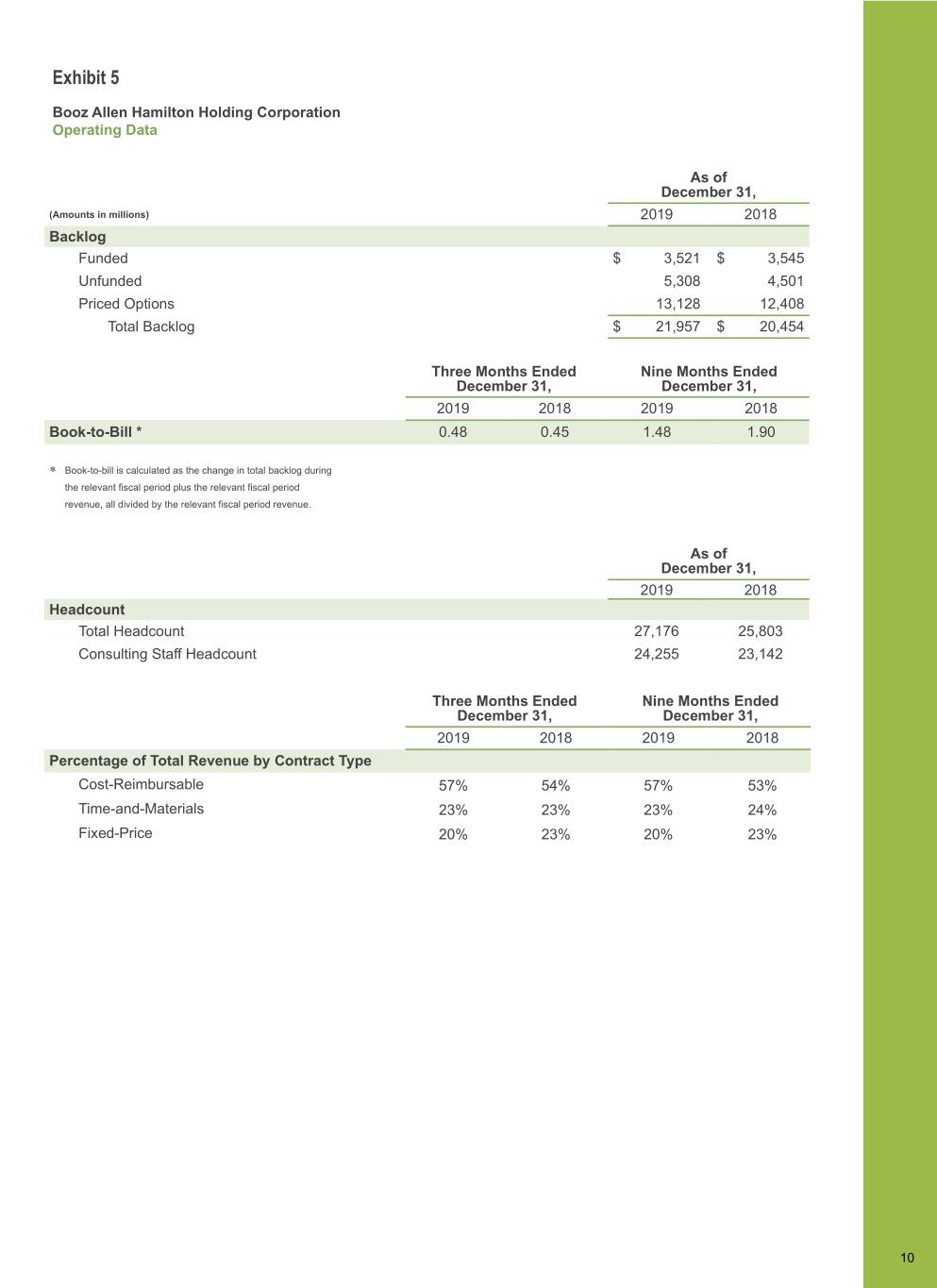
Exhibit 5 Booz Allen Hamilton Holding Corporation Operating Data As of December 31, (Amounts in millions) 2019 2018 Backlog Funded $ 3,521 $ 3,545 Unfunded 5,308 4,501 Priced Options 13,128 12,408 Total Backlog $ 21,957 $ 20,454 Three Months Ended Nine Months Ended December 31, December 31, 2019 2018 2019 2018 Book-to-Bill * 0.48 0.45 1.48 1.90 * Book-to-bill is calculated as the change in total backlog during the relevant fiscal period plus the relevant fiscal period revenue, all divided by the relevant fiscal period revenue. As of December 31, 2019 2018 Headcount Total Headcount 27,176 25,803 Consulting Staff Headcount 24,255 23,142 Three Months Ended Nine Months Ended December 31, December 31, 2019 2018 2019 2018 Percentage of Total Revenue by Contract Type Cost-Reimbursable 57% 54% 57% 53% Time-and-Materials 23% 23% 23% 24% Fixed-Price 20% 23% 20% 23% 101 0
